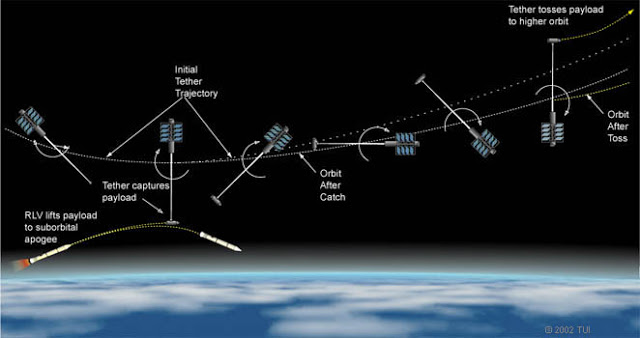Alternatives to Rockets: Skyhooks
Things get much easier if a space elevator cable does not reach the ground, then it can be constructed with current materials. This is the Skyhook concept. A supersonic vehicle (wholly or partly air breathing) would connect with a tether hanging down from a satellite (connecting at a speed of Mach 10 or higher? It’s relative velocity that matters, and in flight refuelling at high speed is well proven).
The two options are a fixed tether ( basically, a short space elevator) along which the space ship would crawl up (how? Linear motors?). The alternative is a rotating tether, which would slingshot the spaceship into orbit, as shown in the diagram below:
 Source: https://skyhooksandspaceelevators.wordpress.com/2015/04/29/hello-world/
Source: https://skyhooksandspaceelevators.wordpress.com/2015/04/29/hello-world/
Studies by Boeing suggest that a rotating tether is more efficient than a fixed one, but this technology allows one to start small and then work out which is best in practice. With a rotating tether, Newton’s third law still applies, and the reaction to the slingshot would lower the anchoring satellite, which would need to lifted back up, possibly through electrodynamics utilising the Earth’s magnetic field.
You can even use a tether to brake a spacecraft returning to Earth. Assuming that the latter is approaching east to west (against the Earth’s rotation) then a tether travelling west to east would catch it and reduce its velocity, imparting some of the craft’s kinetic energy to the tether.
One could start connecting with a launch vehicle at a relatively high level and a connecting speed of Mach 10 or higher, then with experience and developing skyhook materials, making the cable longer and connecting at lower altitude and at lower speeds; Mach 5 or lower could be achieved with airbreathing scramjets, at much lower cost and more safely than with rockets. Eventually and gradually, learning as one goes along, skyhooks may evolve into fully fledged space elevators. The development of space planes as described in a previous post and skyhooks are not mutually exclusive.
There is an excellent video by Isaac Arthur here exploring various options for skyhooks.
There are safety issues. The skyhook would be orbiting well below geosynchronous distance, and in an equatorial orbit would inevitably pass over land masses, notably Africa and South America. If it did fall out of orbit, measures would be needed to make sure it broke up into small enough pieces to burn up in the atmosphere, or could be safely steered into the ocean.
Previous chapter:
Alternatives to Rockets: Space Elevators, Launch Loops, Startram
Next chapter:
Moon and Planets: Not Suitable for Settlement?